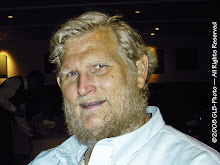
Getty: Paul Outerbridge Exhibit
"Art is life seen through man's inner craving for perfection and beauty—his escape from the sordid realities of life into a world of his imagining. Art accounts for at least a third of our civilization, and it is one of the artist's principal duties to do more than merely record life and nature. To the artist is given the privilege of painting the way."
— Paul Outerbridge (1896 – 1958)
Yesterday (Saturday, June 13) I saw the work of Paul Outerbridge at the Getty Center in West LA. What an experience! While I enjoyed some of his photos more than others, I was especially impressed with his use of photography to create artistic works. He started as an art student, but his real career training started when he attended the Clarence H. White School of Photography in New York City which reflected the photo-successionist views; White was trying to get photography accepted as an art, not just as a reflection of reality.
During this period he learned to use light & shadows to define creative views of everyday objects. His career ranged from the use of these photographic techniques to create architectural images and images for commercial art. Many of the stunning 5" x 7", black and white images created with these techniques are on display in this exhibit. These contact prints were taken by and large in the studio where he could apply some very creative lighting with his exceptional "photographic" vision. He used focused light, in many cases, to highlight particular areas of his subject and created his magic. He was a modernist that blended "art for art's sake and commercial art," resulting in a body of works unlike any other.
His vision, as exemplified in the above quotation, was to capture the essence, but not necessarily provide only a reflection of reality as was the goal of most photographers of his era. Only a few of his landscapes are on exhibit, but these reflect this artistic, etherial feeling that goes beyond the physical elements photographed. As in most of his images, he often employs "soft focus" to help create this artistic image on film.
Two items of special note. The first is found in his focus on the nude figure in photographs taken between the mid 1920s through the late 1940s. Many of these images are on display in this exhibit. Here again, Outerbridge used customized lighting, skillful posing, and a creative use of props to create many beautiful images. This series of nudes rival those produced by the more traditional artist.
The second focus of his work was the use of color before the wide use of Kodachrome became an photographic option. The process that he used, the carbro process, which created brilliant color photographs from three black/white negatives (each taken through a different filter — either a red, green, or blue) that went through an laborious process. In Outerbridge's day, this process used a 5" x 7" view camera needed to take these three images by exposing three pieces of film in succession. This is why many of the earlier images were made of still life that didn't move! Later on, he was able to use this for the more typical studio poses. These color images were better quality than most color films brought out by Kodak, Agfa, and others. These carbro images were vivid and very true to life.
[Note: If you have ever printed color separations from your printer, then created a color, laser transparency from these printouts (in the appropriate color: cyan, magenta, yellow), and then overlaid these images and projected them
via overhead projector, you know that you can create a full-color image from
these three black and white copy.]
Back to the carbro images... The quality of the color in these images, as mentioned above, are far better than produced by most color films. Kodak developed its Kodachrome as early as the late 1930s, but it didn't come into common use by photographers until the latter 1950s. Kodachrome images can't 'hold a candle' to those images created by this carbro process. The only approximation of the vivid, intense color in a color transparency film that could be even compared with the carbo prints is the Fuji Velvia film. Unfortunately, the days of this carbro process is past. It used special gels, special paper, special chemicals, and two days for each print. While there are those who would be willing to spend the time to produce these images, the lack of availability of these materials prevents this from happening. Therefore, this art, as practiced by Outerbridge, is at its end.
[Note: Simultaneous with the Outerbridge exhibit, there is one room devoted to these carbro prints and features the work of Richard C. Miller, a southern California resident. There is also one wall that goes over the carbro process and displays a camera that takes all three negatives simultaneously. This is like a dessert after seeing the many fantastic images by Outerbridge, which is the main course. Using the same analogy, the appetizer for the Outerbridge exhibit is a room of composite images by Jo Ann Callis called "Woman Twirling".]
So, is this exhibit worth your time? By all means! The Getty Center has again put on an exhibit of photographic art that will seldom be replicated. It continues through August 9, 2009; the "Woman Twirling" will be on display through August 9, 2009. Books covering these exhibits are available at the Getty Bookstore (either at the Getty Center or online). These books are good resources and a nice review of the
exhibit.
Books on the Exhibit:
Paul Martineau (2009), Paul Outerbridge: Command Performance, The J. Paul Getty Museum. http://www.getty.edu/bookstore/titles/outerbridge.html
Judith Keller (2009), Jo Ann Callis: Woman Twirling, The J. Paul Getty Museum. http://www.getty.edu/bookstore/titles/callis.html
Paul Martineau, "Richard C. Miller: Master of the Carbro Process," Photoicon. http://www.photoicon.com/online_features/38/

